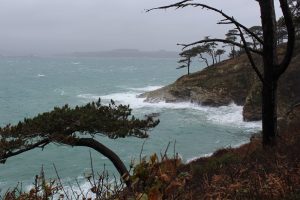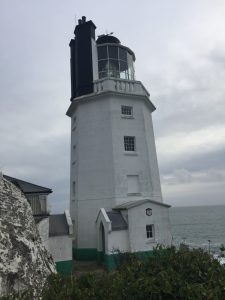‘I knew when I met you an adventure was going to happen’ ~ A.A. Milne
Woken by the foghorns on Falmouth Harbour early this morning, we faced a grey and gloomy day, warm for November, but with mizzling skies. The One & Only had planned to walk the coastal path around the Roseland Peninsula. Uninspired by the weather, I found myself drawn instead to a cosy coffee shop in nearby Portscatho to await his return and make some notes about our time here in Cornwall.
Growing up, it seemed my family always had beach holidays in the winter, which, even in sunny South Australia, can be chilly. Whether it was to dodge the crowds or the excessive cost of summer holiday rentals, I don’t know, but whatever the reason then, I now much prefer a deserted, windblown beach, to the burning sands and burning skins of summer. Going to the beach in winter gives a real sense of escape and a chance to blow away the cobwebs both literally and figuratively. To stride across virgin sand devoid of the detritus of summer – buckets and spades, irksome seagulls snatching chips, gritty sandwiches, beach umbrellas – lifts the spirits and calms the soul.
In Britain, there are 20,000 miles of coastline that incorporate coves and cliffs, dunes and beaches, fishing villages and sprawling sea ports. In Cornwall, one third of this county’s extensive coastline is owned and maintained by the National Trust. Once Cornwall was economically dependent on farming, fishing and mining, but these have long been upstaged by tourism. Now every fishing village has an abundance of antiquated stone cottages available for holiday rentals, and it seems every farm has laid aside a field or two for campers, so that Cornwall now boasts over 160 camping sites.
and sprawling sea ports. In Cornwall, one third of this county’s extensive coastline is owned and maintained by the National Trust. Once Cornwall was economically dependent on farming, fishing and mining, but these have long been upstaged by tourism. Now every fishing village has an abundance of antiquated stone cottages available for holiday rentals, and it seems every farm has laid aside a field or two for campers, so that Cornwall now boasts over 160 camping sites.
It’s a bit of a schlep from almost anywhere in the UK, but for the milder climate, the beautiful countryside and the stunning shoreline, it is well worth the effort. We legged it all the way from Luxembourg, and it was a sheer delight, even in winter. Narrow lanes weave between high hedgerows or under the shadow of oak and beech woods. They follow the curve of merry brooks, and dash round sharp bends to startle an unsuspecting stone farm house or a cosy country pub. When we finally abandon the car, by our own stone cottage above the sea, the southern coastal walk is a joy.
Wildlife abounds. It is not hard to understand Daphne Maurier’s inspiration for her thriller, ‘The Birds,’ as vast flocks of seagulls swoop and soar around the cliffs and black crows amass in the empty fields. We have a friendly heron who waits for us on the road every morning as we drive off to explore another stretch of the glorious Roseland Peninsula, and we are constantly dodging the pheasant – including some surprisingly snowy white ones we have never come across before. Neither chooks, nor albinos, as we first suspect, but an ornamental variety, bred specifically for their pristine feathers. It is somewhat larger than the more typical ring-neck pheasant, and they are apparently very tasty, but these wild ones won’t oblige us by running under the wheels of the car, so it is a dinner I will continue to anticipate, until I can find someone farming them.
Chinese ring-necked pheasants were originally brought to Britain by the Romans around A.D. 1000, but soon disappeared. These days, the countryside is teeming with the more common dappled cock pheasant with its red wattle and glossy green head and its comparatively dowdy, chestnut-coloured spouse. It is a mixed breed, reintroduced as a game bird during the 19th century. The habitat seems to suit them well. Apart from the breeding programs set up by shooting enthusiasts, they have also bred naturally and prolifically in the wild, throughout the British Isles. These daft birds love to play chicken with passing cars, and so far, they are winning, despite barely a single brain between them. In the twilight, they are even more flighty, with a kamikaze approach to car headlights that keeps us crawling at a snail’s pace and lurching to a stop every hundred metres or so, as they either sprint across the lane under our front tyres or take to the air in a panic-ridden flurry of feathers.
 The other appeal of Cornwall’s coast is its many lighthouses. By good luck, we are staying in a comfortable National Trust cottage that squats above the St. Anthony’s lighthouse. Built in 1835, this lighthouse stands directly opposite Falmouth, at the very tip of the Roseland Peninsula, and about 200m from our front door. The One & Only, with a long-standing passion for lighthouses, has collected photos of ‘our’ lighthouse in much the same way that Monet collected haystacks.
The other appeal of Cornwall’s coast is its many lighthouses. By good luck, we are staying in a comfortable National Trust cottage that squats above the St. Anthony’s lighthouse. Built in 1835, this lighthouse stands directly opposite Falmouth, at the very tip of the Roseland Peninsula, and about 200m from our front door. The One & Only, with a long-standing passion for lighthouses, has collected photos of ‘our’ lighthouse in much the same way that Monet collected haystacks.
One blustery afternoon, we turn right at the lighthouse and follow the coastal path north, where fierce winds threaten to throw us off the edge of the narrow path onto the jagged rocks below. The shrubs and trees along this exposed ridge have been buckled and bent by a feisty wind that is all too obviously a regular visitor. Eventually, we turn a corner into more secluded fields, and follow the path through the woods to Place House and the parish church of St Anthony. Originally built in 1150 beside an Augustinian Priory, the church was extensively restored in the 19th century. The priory itself was pulled down during the dissolution of the monasteries in the 16th century, but the site was recovered in 1840 to build Place House, the home of the Spry family, and the church, still consecrated, is filled with memorial plaques to members of that family, a number of whom held senior positions in the Royal Navy during the 19th century.
On yet another blustery day, we turn left at the lighthouse towards Portscatho. En route, we find an isolated beach where we spot a couple of grey seals, obese as walruses, lounging lazily on the rocks, while their young pups play in the waves.
Long a fan of Daphne du Maurier and Mary Wesley, I was excited to discover that many of their book and film locations can be found in the area. ‘Menabilly’ at Fowey was the inspiration for ‘Rebecca’ and her beloved Manderley, while Broom Parc, at Port Looe, was the location for the miniseries ‘The Camomile Lawn’. There is an actual Frenchman’s Creek, a tributary of the Helford River, and Jamaica Inn is a real pub on Bodmin Moor. Many other writers have escaped to this region for inspiration. Maybe, one of these days, I will follow their example. Now, we must reluctantly pack our bags and lock the door on our snug and tranquil cottage. As we drive for the last time, up the now familiar country lane, half a dozen foolish and feeble-minded pheasants dash out into the middle of the road and our friendly heron, lanky legs loosely dangling, rises sedately into the cloudy, grey sky.
*with grateful thanks to the One & Only and E.H. Shepherd for the perfect pics.

